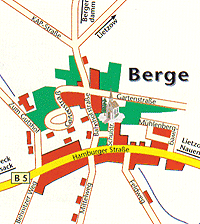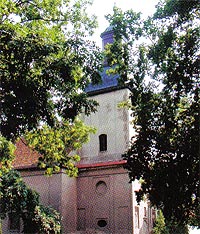












The village Berge was first recorded in 1292. As nearly everywhere in the rural area the village developed only slowly. There were only 52 houses in Berge in the year 1840. That changed in the 20th-century when the first migration from the city started that's why in 1931 there were already 152 residences with 1113 citizens. In the year 1948, after the 2nd World War, the estate Berge of the agricultural-horticultural faculty of the university Berlin was transferred through the land reform as research estate to state ownership. In the year 1954 the collectivisation took place here also with first nine members.
Six years later there were already 52 members, who worked the 614 hectare of agricultural area. Today the village has, due to its location at the Bundesstraße five the best pre-condition for good economical development, whereby agriculture still plays the dominant role.

The furbished church stems from the year 1744. It has large windows, which have flat pointed arches. The end of the spire forms a square massive tower with a octagonal wooden lantern from 1775/76. The bell tower houses three bells, one with gothic minuscule.
Especially interesting are the mummies that lay in the Church's vault. Through the extremely dry air condition in the vault the bodies of a man and a woman were mummified over the course of 400 years in a natural way. These mummies are, by the way, better preserved the the better known knight Kahlbutz in Kampehl. It is assumed the bodies stem from the family von Hacke.
The pictures + content on this page were kindly made available by Stadtmagazinverlag AS GmbH. Photo: Stadtmagazinverlag AS